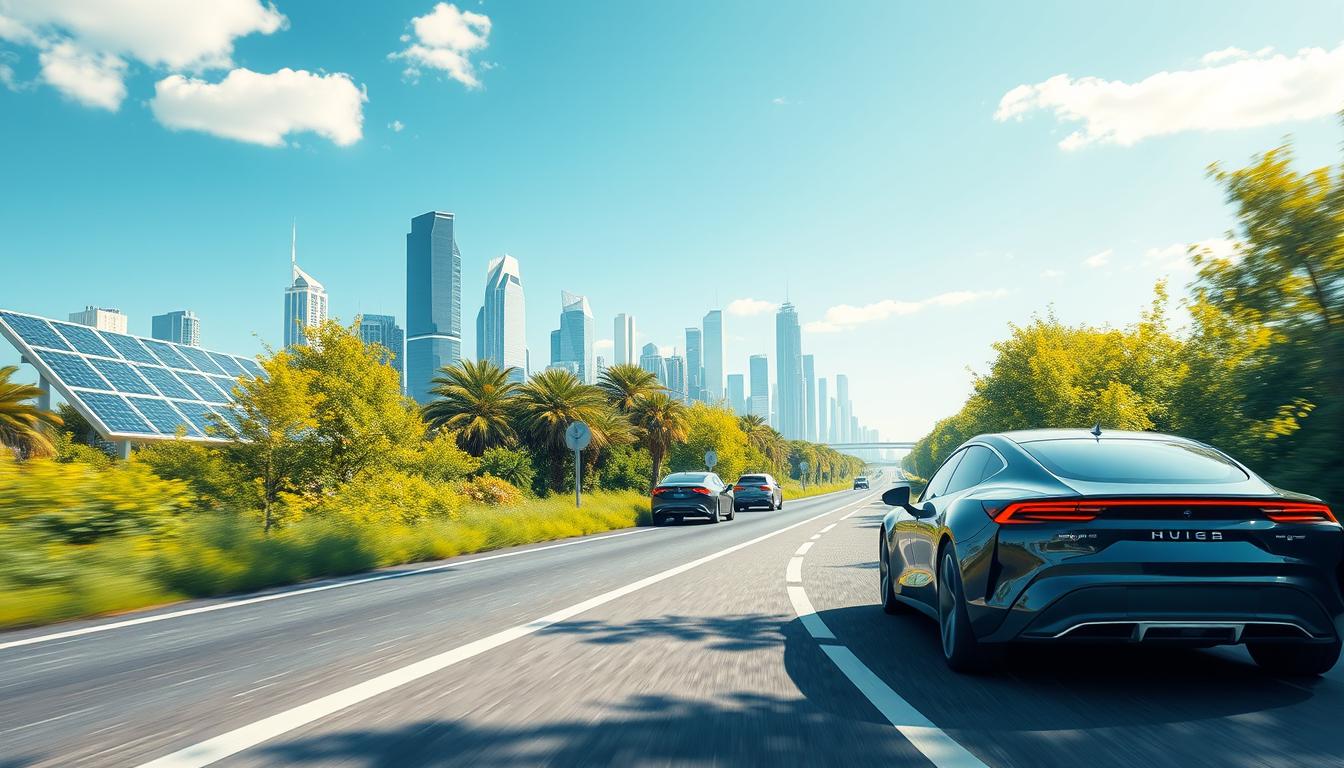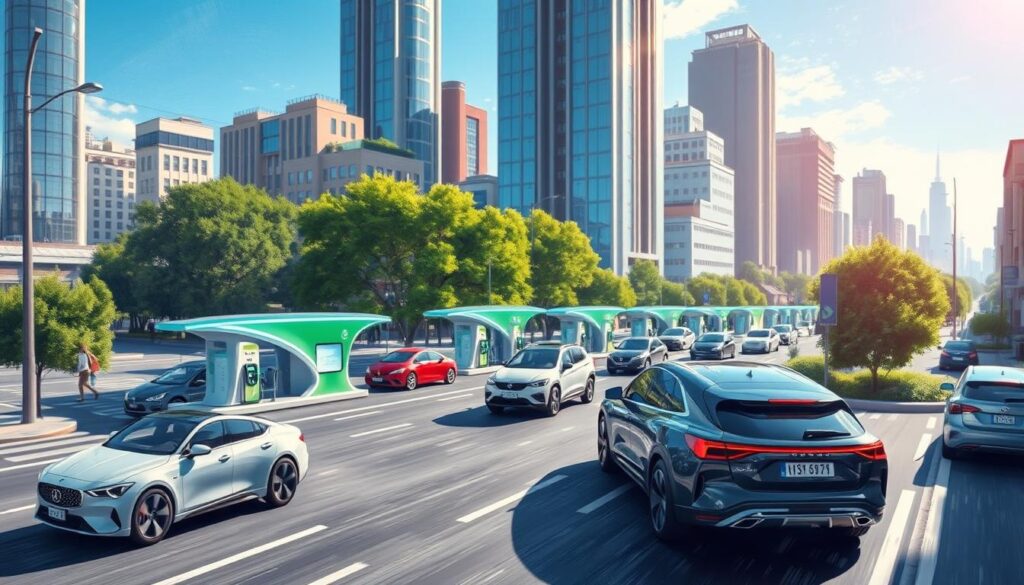
The world is moving towards cleaner energy, and hydrogen cars are getting attention. They could help cut down carbon emissions. But are they really fast to refuel and can they go far, making them a good choice over traditional cars?
Hydrogen cars, also known as hydrogen powered cars, have many benefits. They produce zero emissions and can travel long distances without needing to recharge. As we focus more on reducing carbon emissions, hydrogen cars are becoming a good choice for those who care about the environment.
Key Takeaways
- Hydrogen cars can be refueled in 3-5 minutes, providing a fast refueling experience
- Hydrogen fuel cell cars can carry enough hydrogen for 300-400 miles of range
- Fuel cell cars qualify for the Clean Air Vehicle decal in California, allowing solo driving in carpool lanes
- Hydrogen sells for considerably more than gasoline at the pump, but fuel cell cars can travel about twice as far as conventional cars on an equivalent amount of fuel
- A $4,500 rebate is available for fuel cell cars in California through the Clean Vehicle Rebate Project
- Hydrogen cars have distinct power generation mechanisms compared to battery electric vehicles, utilizing hydrogen fuel cells instead of batteries
Let’s dive into the world of hydrogen cars. We’ll look at their benefits and challenges. We’ll see what they mean for the future of transportation. From how they work to their environmental benefits and challenges, we’ll cover everything you need to know about hydrogen powered cars.
What Are Hydrogen Cars and How Do They Work?
Hydrogen cars, also known as hydrogen fuel cars, use hydrogen as fuel. They are getting more attention for cutting down on greenhouse gas emissions and fossil fuel use. These cars turn hydrogen into electricity to power an electric motor.
A fuel cell is key to making hydrogen cars work. It mixes hydrogen and oxygen to create electricity, leaving water and heat behind. This makes hydrogen cars a green choice for travel.
Basic Operating Principles
Hydrogen fuel cars work in a straightforward way. They store hydrogen in a tank and then use it in a fuel cell. The fuel cell mixes hydrogen with oxygen to make electricity. This electricity powers the car’s electric motor.
The only things these cars emit are water vapor and heat. This makes them a zero-emission vehicle.
Fuel Cell Technology Explained
Fuel cell technology is vital for hydrogen cars. It turns hydrogen and oxygen into electricity, leaving water and heat. This tech has been getting better, with lots of investment in research.
Key Components of Hydrogen Vehicles
Hydrogen cars have important parts like the fuel cell, electric motor, and hydrogen tank. The fuel cell is the core, turning hydrogen into electricity. The electric motor uses this electricity to move the car.
The hydrogen tank stores the fuel. As more people want hydrogen cars, we’ll see new improvements in these parts.
The Evolution of Hydrogen Powered Cars
Hydrogen powered cars have a long history, starting in the early 19th century. The first one was made in 1806 by Francois Isaac de Rivaz. This was before gasoline cars by almost 80 years. Since then, the technology has grown a lot, with big car makers focusing on hydrogen cars.
Now, you can find hydrogen cars like the Toyota Mirai and the Hyundai Nexo. They have many good points, like no emissions and better fuel use. The American Department of Energy says fuel cell costs have dropped by 80% since 2002. This makes hydrogen cars a better choice for people.
Even with challenges, many countries are putting money into hydrogen fuel cell tech. The global market is expected to hit $13.7 billion by 2026. Key players include Toyota, Hyundai, and BMW.
- Toyota
- Hyundai
- BMW
These companies are working hard to make hydrogen cars better and cheaper. This will help the market grow in the next few years.
In the U.S., only about 15,000 hydrogen cars are on the road, mostly in California. But, with more money going into hydrogen tech, we’ll see more cars soon.
| Year | Event |
|---|---|
| 1806 | First hydrogen-powered vehicle invented |
| 1966 | General Motors’ Electrovan, one of the first fuel cell electric vehicles (FCEVs) |
| 2014 | Toyota Mirai, the world’s first dedicated mass-produced fuel cell vehicle |
Environmental Benefits and Challenges
Hydrogen cars offer many environmental benefits. They have zero emissions and can travel far. The U.S. transportation sector uses about 30% of all energy and 70% of oil. This makes it a big source of greenhouse gas emissions.
Hydrogen fuel cells in big vehicles can cut U.S. emissions by 27%. This is a big step towards cleaner air. Hydrogen cars also don’t make noise pollution.
But, making hydrogen now mostly uses fossil fuels. This means most hydrogen is made from oil, releasing carbon dioxide. To really help the environment, we need more green hydrogen, which is only 5% of what we make.
Zero Emissions Promise
Hydrogen fuel cells are very efficient, up to 65%. This is much better than old power plants, which are only 33-35% efficient. Using renewable energy to make hydrogen can greatly cut down on emissions.
Production Carbon Footprint
But, making hydrogen cars has a big problem: the carbon footprint. Most hydrogen is made by burning fossil fuels, which adds to emissions. We need to use more solar or wind power to make hydrogen.
Sustainability Considerations
For hydrogen cars to become common, we need to think about sustainability. Making hydrogen stations cheaper is key. Also, making fuel cells more efficient and affordable is important for a greener future.
Comparing Hydrogen Cars to Other Alternative Vehicles
Hydrogen powered cars are often compared to battery electric vehicles and hybrids. Hydrogen cars have a long range and quick refueling. For instance, the Toyota Mirai can go over 400 miles and refuel in under 5 minutes.
Battery electric vehicles have a shorter range and take longer to charge. Yet, they are cheaper and have lower running costs. The cost of hydrogen and cars is also a big factor, with a full tank costing £50-75. Here are some key differences between hydrogen cars and other alternative vehicles:
- Range: Hydrogen cars can go 400-600 miles, while battery electric vehicles go 100-350 miles.
- Refueling time: Hydrogen cars refuel in under 5 minutes, while battery electric vehicles take up to 20 hours.
- Operating cost: Hydrogen cars cost more to run, with hydrogen fuel being about 4 times more expensive than electricity for battery electric vehicles.

In conclusion, hydrogen powered cars have some benefits over other alternatives. However, they also have significant drawbacks. As technology improves, we can expect better ranges, efficiency, and prices for hydrogen and cars.
| Vehicle Type | Range | Refueling Time | Operating Cost |
|---|---|---|---|
| Hydrogen Car | 400-600 miles | Under 5 minutes | Higher |
| Battery Electric Vehicle | 100-350 miles | Up to 20 hours | Lower |
Current Market Leaders and Available Models
The market for hydrogen fuel cars is expanding fast. Several companies are now offering their own models. Toyota leads the way with its toyota hydrogen car lineup, which is very popular. The Toyota Mirai is a standout hydrogen fuel car that has caught a lot of attention lately.
Other brands like Hyundai are also jumping into the game. The Hyundai Nexo is another hit model that many people like. These cars are great because they don’t emit any pollution and are very quiet and smooth to drive.
Here are some key features of current market leaders and available models:
- Toyota Mirai: a toyota hydrogen car with a range of up to 312 miles
- Hyundai Nexo: a hydrogen fuel car with a range of up to 380 miles
- Other models: such as the Honda Clarity Fuel Cell and the Mercedes-Benz GLC F-Cell
| Model | Range | Price |
|---|---|---|
| Toyota Mirai | up to 312 miles | around $58,000 |
| Hyundai Nexo | up to 380 miles | around $59,000 |
As more people look into hydrogen fuel cars, we’ll see even more options. These new models will offer different benefits and features for everyone.
Infrastructure and Fueling Network
The need for hydrogen cars and hydrogen powered cars is growing fast. Building a wide network of fueling stations is key. Right now, there are only 66 stations in California, aiming for 100. Each station costs about $2 million to build and keep up.
Not having enough stations is a big hurdle for hydrogen cars. There are over 145,000 stations for regular cars in the U.S. To grow hydrogen cars, we need to invest a lot, maybe tens of billions of dollars.
Some important facts about hydrogen fueling stations are:
- 66 operational hydrogen stations in California as of July 2024
- Average cost of $2 million per station
- Over 145,000 fueling stations across the U.S. for internal combustion engine vehicles
- Potential investment of tens of billions of dollars needed to support the growth of hydrogen fuel cell electric vehicles
Groups like the National Renewable Energy Laboratory (NREL) are studying hydrogen stations. They look at how many, how often they’re used, and where they are. The Alternative Fuels Data Center also helps by showing where hydrogen stations are in the U.S. As we build more stations, we must tackle the infrastructure problem. This will help hydrogen cars and hydrogen powered cars grow.
| State | Number of Hydrogen Stations | Average Cost per Station |
|---|---|---|
| California | 66 | $2 million |
| U.S. Total | 145,000 (gas stations) | N/A |
Safety Considerations and Technology Advancements
Hydrogen fuel cars have seen big improvements in safety. Many makers and researchers are working hard to make these cars safer. Hydrogen fuel cells are very energy-dense, giving cars about 330-400 miles on 6kg of fuel. This makes for efficient, clean, and safe travel.
The Natural Resources Defense Council (NRDC) says hydrogen is safer than gasoline. It has lower radiant heat and needs more oxygen to explode. Plus, hydrogen is not toxic to humans, making it safer than fossil fuels. The US Department of Energy adds that hydrogen is lighter than air, which helps it spread out quickly in case of a leak.
Some key safety features of hydrogen fuel cars include:
- High flammability but low radiant heat
- High O2 requirement for explosions
- Non-toxic and non-poisonous to humans
New tech like graphene is making hydrogen fuel cells safer and more durable. Toyota’s hydrogen combustion engine is another step forward in hydrogen safety. It could open up new possibilities for safe hydrogen use.
The table below shows how hydrogen compares to methane and gasoline for safety:
| Property | Hydrogen | Methane | Gasoline |
|---|---|---|---|
| Flammability | High | Medium | High |
| Radiant Heat | Low | Medium | High |
| Toxicity | Non-toxic | Non-toxic | Toxic |
Cost Analysis and Ownership Experience
Looking into hydrogen cars means checking their cost and how they feel to own. The 2024 Toyota Mirai, a hydrogen car, starts at $50,190. This is more than the 2024 Toyota Corolla Hybrid, which begins at $23,500.
Fueling hydrogen cars can be pricey. A full tank for the Toyota Mirai costs about $200. But, the Toyota Corolla Hybrid only costs $35 to $45 to fill up. The Toyota Mirai’s 65 MPGe efficiency helps make up for the higher fuel costs.
When thinking about owning a hydrogen car, remember these points:
- Purchase price: Hydrogen cars are pricier than hybrids.
- Fuel costs: Hydrogen fuel is more expensive than gasoline.
- Maintenance costs: Hydrogen cars might need more special care, which can add to costs.
- Depreciation: Hydrogen cars might lose value faster than hybrids because of limited refueling spots and smaller appeal.
Despite these points, many hydrogen car owners are happy. They like the zero emissions and lower costs over time. Hydrogen cars are a good choice for those wanting a greener way to travel.
| Vehicle | Purchase Price | Fuel Cost | Efficiency |
|---|---|---|---|
| 2024 Toyota Mirai | $50,190 | $200 (full refill) | 65 MPGe |
| 2024 Toyota Corolla Hybrid | $23,500 | $35-$45 (full tank) | 50 MPG |
Conclusion: The Future of Hydrogen in Transportation
Hydrogen cars are a promising alternative to traditional cars. Big car makers are working on them. These cars run on hydrogen and only make water and heat, helping the air and the planet.
Fueling up hydrogen fuel cars is quick, like gas or diesel cars. This makes them better for public use than electric cars. They also go as far as or farther than cars that use fossil fuels, easing worries about running out of charge.
Cities like London, Tokyo, and Los Angeles are using hydrogen buses. This shows hydrogen can work in public transport. Also, Germany’s hydrogen train is a big success, showing hydrogen’s potential in trains.
But, there are still hurdles like infrastructure and cost. Yet, governments and companies are investing in green hydrogen and more fueling stations. As technology improves and costs drop, hydrogen fuel cars will play a bigger role. They could help make our future cleaner and greener.
FAQ
What are hydrogen cars and how do they work?
Hydrogen cars, also known as fuel cell electric vehicles (FCEVs), run on hydrogen fuel cells. These cells turn hydrogen gas into electricity to power an electric motor. This makes hydrogen cars a clean alternative to gasoline cars.
What are the key components of a hydrogen vehicle?
A hydrogen car has a few main parts. The fuel cell stack makes electricity from hydrogen. The electric motor powers the car. The battery helps with extra power when needed.
What are the environmental benefits of hydrogen cars?
Hydrogen cars don’t produce direct emissions, making them eco-friendly. But, how hydrogen is made can affect the environment. It’s key to consider this for hydrogen cars to be truly green.
How do hydrogen cars compare to other alternative vehicles?
Hydrogen cars are faster to refuel and can go longer than electric cars. But, they cost more upfront. Hybrid cars offer a middle ground between traditional cars and hydrogen or electric ones.
What are the current market leaders and available hydrogen car models?
Toyota leads in hydrogen cars with models like the Toyota Mirai. Hyundai and Honda also offer hydrogen cars. Prices and availability vary by region.
What is the current state of the hydrogen fueling infrastructure?
There aren’t many hydrogen fueling stations yet. This is a big hurdle for hydrogen cars. But, efforts are being made to grow the network and support hydrogen cars.
What are the safety considerations and technology advancements in hydrogen cars?
Hydrogen cars are tested for safety and have advanced systems. They handle hydrogen safely. Technology is also improving fuel cell efficiency and durability.
What is the cost analysis and ownership experience of hydrogen cars?
Hydrogen cars cost more to buy than regular cars. But, they might save money on running and maintenance costs. Owner experiences share insights on refueling and upkeep.







